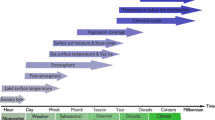An early example is von Neumann's and Charney's Princeton Meteorological Project in the period 1946–53 which ended with daily numerical prediction in less than 2 hours. After this stage, the questions of long-range forecasting and general circulation of the atmosphere became of greater importance. The late 1950s saw the emergence of an alternative: were atmospheric models used mainly for prediction or understanding? This controversial debate in particular occurred during an important colloquium in Tokyo in 1960 which gathered together J. Charney, E. Lorenz, A. Eliassen, and B. Saltzman, among others, and witnessed discussions on statistical methods for predictions and/or maximum simplification of dynamic equations. This phase ended in 1963 with Lorenzs seminal paper on “Deterministic non periodic flows.”
Similar content being viewed by others
Author information
Authors and Affiliations
Additional information
(Received February 11, 2000)
Rights and permissions
About this article
Cite this article
Dalmedico, A. History and Epistemology of Models: Meteorology (1946–1963) as a Case Study. Arch Hist Exact Sc. 55, 395–422 (2001). https://doi.org/10.1007/s004070000032
Issue Date:
DOI: https://doi.org/10.1007/s004070000032




